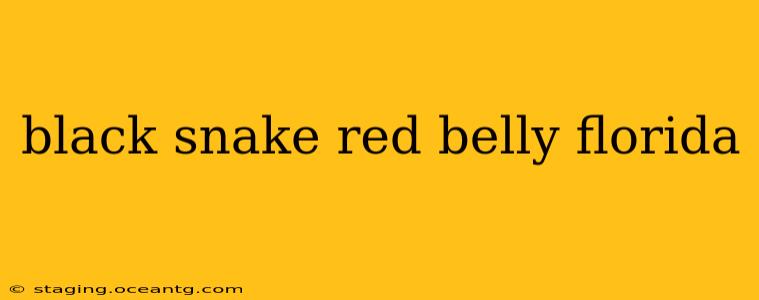Florida boasts a rich diversity of snake species, and among them, the "black snake red belly" is a term often used, though not precisely scientific. This phrase generally refers to snakes exhibiting a dark dorsal (top) coloration and a reddish or orange ventral (belly) side. Several species in Florida fit this description, leading to some confusion. This guide clarifies the identification and behavior of these snakes, addressing common questions.
What kind of snake is black on top and red on the bottom in Florida?
Several snakes in Florida could be described as black on top and red on the bottom, depending on the specific shade and pattern variations. The most likely candidates include:
-
Eastern Scarlet Snake ( Cemophora coccinea): This relatively small snake is typically less than 2 feet long and exhibits striking red, black, and yellow bands. While the red is prominent on the belly, the "black" is actually broken into distinct bands, not a solid color. This species is generally harmless.
-
Florida Scarlet Snake ( Cemophora coccinea copei): A subspecies of the Eastern Scarlet Snake, it’s also small and exhibits similar banding patterns of red, black, and yellow. It's also non-venomous.
-
Speckled Kingsnake ( Lampropeltis getula holbrooki): This larger snake can reach up to 4 feet in length. Its coloration can vary, sometimes presenting a dark dorsal side with reddish or orange tinges on the belly, particularly in younger individuals. The pattern is more blotched and less distinctly banded. It's non-venomous and a beneficial predator of rodents.
It's crucial to note that the term "black snake red belly" is imprecise and doesn't pinpoint a specific species. Accurate identification requires close observation of the snake's full pattern, size, and habitat.
Are black snakes with red bellies poisonous?
No, the snakes in Florida typically described as "black snake red belly" are not venomous. The species mentioned above—Eastern and Florida Scarlet Snakes and Speckled Kingsnakes—are all non-venomous constrictors. They subdue their prey by constriction, not venom.
However, it's always advisable to approach any wild snake with caution and avoid handling it unless you are experienced in snake identification and handling. Mistaking a non-venomous snake for a venomous one can lead to unnecessary fear and harm to both the snake and the person.
How big do black snakes with red bellies get?
The size varies greatly depending on the species. The Scarlet Snakes remain relatively small, usually under 2 feet. The Speckled Kingsnake, on the other hand, can grow significantly larger, reaching up to 4 feet in length.
What do black snakes with red bellies eat?
The diet also varies depending on the species. Scarlet Snakes primarily feed on small lizards and other snakes, while Speckled Kingsnakes are known to consume rodents, lizards, and other snakes. Their diet plays a vital role in maintaining ecological balance.
What is the lifespan of a black snake with red belly?
The exact lifespan of these snakes varies by species and environmental conditions. However, in optimal conditions, they can live for several years. Specific lifespan data for each species is often limited and requires further research.
How can I tell if a snake is poisonous in Florida?
Identifying venomous snakes in Florida requires careful observation and knowledge of their characteristics. Several key features distinguish venomous snakes from non-venomous ones:
- Pupil Shape: Venomous snakes typically have elliptical or cat-like pupils, while non-venomous snakes usually have round pupils.
- Head Shape: Many venomous snakes have triangular-shaped heads, though not all.
- Heat-Sensing Pits: Pit vipers (like copperheads and rattlesnakes) possess heat-sensing pits between their eyes and nostrils.
- Pattern and Coloration: While coloration is not a reliable indicator, specific patterns can be helpful when combined with other features. Refer to field guides for detailed information on venomous species in Florida.
If you encounter a snake you suspect to be venomous, maintain a safe distance and contact a wildlife professional for identification and removal if necessary.
This information provides a better understanding of snakes often described as "black snake red belly" in Florida. Remember, accurate identification is crucial, and seeking expert advice when unsure is always the safest approach. Always prioritize your safety and the safety of the snake.
